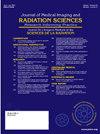Imaging Rejection Rate Analysis in Four-Field Breast Radiotherapy
IF 1.3
Q3 RADIOLOGY, NUCLEAR MEDICINE & MEDICAL IMAGING
Journal of Medical Imaging and Radiation Sciences
Pub Date : 2025-05-01
DOI:10.1016/j.jmir.2025.101954
引用次数: 0
Abstract
Purpose/Aim
At Princess Margaret Cancer Centre, two-dimensional megavoltage portal imaging is predominately used to verify positional accuracy for breast cancer patients undergoing 4-field radiotherapy. It is acquired and assessed daily by radiation therapists with an online correction of 0.5 cm translational tolerance. Depending on the dose fractionation, an offline approval of all day 1 images was required by radiation oncologists prior to the second or fourth fractions of treatments. A quality assurance task was conducted in 2023. The purpose was to evaluate the imaging rejection rate, reasons of rejection, and to implement strategies in further reducing rejection rates.
Methods/Process
Between Oct 2018 and August 2021, forty-four patients receiving 4-field breast radiotherapy had at least one day 1 image rejected by oncologists. There was a total of 51 rejections (38 supra-clavicular fields and 13 chestwall/breast fields). This was about 5% of all 879 patients treated with this technique during this time. All patients were treated on Elekta Agility linear accelerators equipped with iView electronic portal imager. All relevant images and documentation were retrieved in Mosaiq information system. Among all the reasons, the clavicle displacement of ≥ 0.5 cm accounted for 52% of the rejection. Inadequate lung distance of breast fields had the second highest rate of 34%. Poor imaging preprocessing and preparation occurred in 9%. Next, an experienced frontline therapist undertook a routine registration process for all rejected images, this peer-review process aimed to identify any variation in decision making between therapists and oncologists.
Results or Benefits/Challenges
Three areas of improvement were identified. First, an inter-observer variability exists when choosing different anatomical references. For example, therapists routinely used central-lung distance to guide the anterior-to-posterior shifts while oncologists may follow maximal heart distance. Second, the use of different measurement and visualization tools in iView and Mosaiq may contribute to additional few millimeters of difference, for example, using different bordering enhancement or performing template matching versus point measurements. Finally, day 1 procedures can be quite lengthy and patients may alter arm position in between imaging fields. Continuous monitoring of the stability of patient position was needed on subsequent treatments.
Conclusions/Impact
This quality analysis of breast imaging improves inter-professional communication. The benefits and pitfalls of different registration strategies were discussed during breast qa rounds. The recommendations were disseminated to frontline therapists in an one hour imaging refresher training. This quality assessment was repeated six months after the training. In a group of 180 patients, the imaging rejection rate decreased to 3.3%. The increased alignment of inter-professional practice in imaging assessment has phased out day 1 imaging approval. Ongoing imaging refresher training is the key strategy to increase patient positioning accuracy and improve clinical efficacy.
乳腺四场放射治疗的影像学排异率分析
目的:在玛格丽特公主癌症中心,二维巨压门静脉成像主要用于验证乳腺癌患者接受四场放疗的位置准确性。放射治疗师每天通过在线校正0.5 cm平移容差来获得和评估它。根据剂量分级,放射肿瘤学家需要在第二次或第四次治疗之前对全天第一天的图像进行离线批准。2023年进行了质量保证任务。目的是评估影像学排斥率,排斥原因,并实施进一步降低排斥率的策略。在2018年10月至2021年8月期间,44名接受四场乳房放疗的患者至少有一次第一天的图像被肿瘤学家拒绝。共有51处排斥(锁骨上区38处,胸壁/乳房区13处)。在此期间接受该技术治疗的879名患者中,这一比例约为5%。所有患者均采用Elekta Agility线性加速器和iView电子门静脉成像仪进行治疗。所有相关图像和文献均在Mosaiq信息系统中检索。在所有原因中,锁骨移位≥0.5 cm占排斥的52%。胸野肺距不足的比例第二高,为34%。9%的患者成像预处理和准备不良。接下来,一位经验丰富的一线治疗师对所有被拒绝的图像进行例行登记,这一同行评审过程旨在确定治疗师和肿瘤学家之间在决策方面的任何差异。结果或益处/挑战确定了三个改进领域。首先,在选择不同的解剖参考时存在观察者之间的可变性。例如,治疗师通常使用中央肺距离来指导前后移位,而肿瘤学家可能遵循最大心脏距离。其次,在iView和Mosaiq中使用不同的测量和可视化工具可能会导致额外的几毫米差异,例如,使用不同的边界增强或执行模板匹配与点测量。最后,第一天的手术可能相当漫长,患者可能会在成像场之间改变手臂位置。在后续治疗中需要持续监测患者体位的稳定性。结论/影响乳腺影像学质量分析提高了专业间的沟通。不同的注册策略的好处和缺陷进行了讨论,在乳腺质量保证轮。这些建议在一个小时的影像学复习培训中传播给一线治疗师。培训后6个月再次进行质量评估。在180例患者中,影像学排异率降至3.3%。在成像评估中,越来越多的跨专业实践已经逐步淘汰了第一天的成像批准。持续的影像学复习培训是提高患者定位准确性和提高临床疗效的关键策略。
本文章由计算机程序翻译,如有差异,请以英文原文为准。
求助全文
约1分钟内获得全文
求助全文
来源期刊

Journal of Medical Imaging and Radiation Sciences
RADIOLOGY, NUCLEAR MEDICINE & MEDICAL IMAGING-
CiteScore
2.30
自引率
11.10%
发文量
231
审稿时长
53 days
期刊介绍:
Journal of Medical Imaging and Radiation Sciences is the official peer-reviewed journal of the Canadian Association of Medical Radiation Technologists. This journal is published four times a year and is circulated to approximately 11,000 medical radiation technologists, libraries and radiology departments throughout Canada, the United States and overseas. The Journal publishes articles on recent research, new technology and techniques, professional practices, technologists viewpoints as well as relevant book reviews.
 求助内容:
求助内容: 应助结果提醒方式:
应助结果提醒方式:


